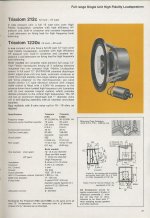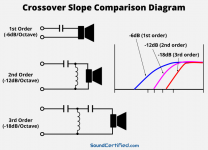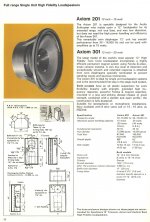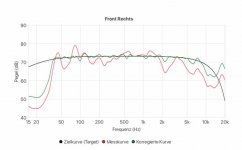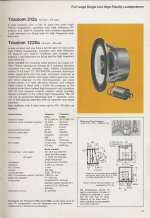must add, that the speaker sound and musicality benefits a lot from a long 'burning-in time' in my experience.The mids and highs with my triaxioms are beautiful without any issues and there's plenty of bass depending on the room. They're my main speakers after building the enclosures in 2012. I've got the issue with one speaker, where the voice coil scratched at medium volume. This was probably caused by shipping. After two months the voice coil has centered itself and this issue had gone. I found, that the high mids weren't as good as the rest. The original cross-over is calculated around 5 - 7 kHz. I've replaced the original capacitor with a lower value (1 mF) and bypassed the coil and the variable resistor. The 'Trebax', which is connected with inverted polarity, is now an auxiliary tweeter and the woofer works as fullrange. The volume of the enclosure is 10 % smaller than recommended (with ARU 172) and the baffle is also less wide.
The walls inside are covered with felt and I've installed 2 curtains with thin felt as proposed in original drawings. Recently I've checked out a modification with a kind of transmission line in one cabinet and measured with the audio analizer of my smartphone a little difference, in my view an improvement in bass response. My amp is a 2A3 PP triode amp (ai faa) and the speakers are connected to the 16 Ohms tab. This combination works great. With my ACA amp, the bass response is weak and overall it looks to be stressed to much, probably because of the speaker load at the low end.
I can't find a published schematic, but the HF unit is crossed over at 5,000Hz by a 2nd order high pass (12dB/octave) L-C network with integral L-pad.Hello, I seek crossover scheme for 1220C.
Do you have the 8 ohm or 15-16 ohm version?
A second order crossover for 8 ohm would have L = 0.36mH and C = 2.8uF.
A second order crossover for 16 ohm would have L = 0.72mH and C = 1.4uF
Attachments
16 ohms
thanks++++
thanks++++
I can't find a published schematic, but the HF unit is crossed over at 5,000Hz by a 2nd order high pass (12dB/octave) L-C network with integral L-pad.
Do you have the 8 ohm or 15-16 ohm version?
A second order crossover for 8 ohm would have L = 0.36mH and C = 2.8uF.
A second order crossover for 16 ohm would have L = 0.72mH and C = 1.4uF
The DIY enclosure designs from Goodmans suited all of their 12" drivers produced at the time. There's a large reflex enclosure design shown in the attachment.guys, what do you think, which is the best without ARU enclosure type/plan for 1220c ?
Goodmans produced a commercial loudspeaker called the A.L. 120 REPRODUCER which contained the Triaxiom and was extremely compact compared to the DIY designs. It did have an ARU on the back, but if a small enclosure is required it may be worth experimenting with a resistive vent. http://ukhhsoc.torrens.org/makers/Goodmans/1960_High_Fidelity_Loudspeaker_Manual/Page16.jpeg
Attachments
thank you!
The DIY enclosure designs from Goodmans suited all of their 12" drivers produced at the time. There's a large reflex enclosure design shown in the attachment.
Goodmans produced a commercial loudspeaker called the A.L. 120 REPRODUCER which contained the Triaxiom and was extremely compact compared to the DIY designs. It did have an ARU on the back, but if a small enclosure is required it may be worth experimenting with a resistive vent. http://ukhhsoc.torrens.org/makers/Goodmans/1960_High_Fidelity_Loudspeaker_Manual/Page16.jpeg
I can't find a published schematic, but the HF unit is crossed over at 5,000Hz by a 2nd order high pass (12dB/octave) L-C network with integral L-pad.
Do you have the 8 ohm or 15-16 ohm version?
A second order crossover for 8 ohm would have L = 0.36mH and C = 2.8uF.
A second order crossover for 16 ohm would have L = 0.72mH and C = 1.4uF
Could someone please check their crossovers? Mine is saying 1.5uF which concur with what DamaDama said in post#8.
1.5uF was in my Triaxioms 15Ohm xover. I‘v replaced it with 1uF and bypassed the coil to use the woofer as a fullrange driver and the HF horn as an auxiliary tweeter. I’m very comfortable with that mod since some years
The crossover components values are not too critical - some leeway is possible
Have you physically connected and auditioned any crossover components yet?
I would experiment with the a standard L value of either 0.6mH or 0.8mH, and a standard capacitor value of 1.5uF and see how the speaker sounds.
Have you physically connected and auditioned any crossover components yet?
I would experiment with the a standard L value of either 0.6mH or 0.8mH, and a standard capacitor value of 1.5uF and see how the speaker sounds.
Last edited:
Galu,
I have connected mine up and to me they sounded a bit thin. Caps are probably kicking the bucket. Mine is also the 8 ohm version. But if 1.5uF is the standard value then crossing at 9.5KHz 2nd Order BW is way too high as the brochure states crossing point is at 5KHz?
100ohms
Yeah I'm liking that green frequency response graph. I think I will try your mod. 🙂
I have connected mine up and to me they sounded a bit thin. Caps are probably kicking the bucket. Mine is also the 8 ohm version. But if 1.5uF is the standard value then crossing at 9.5KHz 2nd Order BW is way too high as the brochure states crossing point is at 5KHz?
100ohms
Yeah I'm liking that green frequency response graph. I think I will try your mod. 🙂
Attachments
I edited out the part of my post to which you appear to be responding, as I wasn't sure whether DamaDama was referring to the 8 ohm or 16 ohm versionMine is also the 8 ohm version. But if 1.5uF is the standard value then crossing at 9.5KHz 2nd Order BW is way too high as the brochure states crossing point is at 5KHz?
If it was the 8 ohm version, then the LC values he gave would, indeed, produce a crossover frequency of around 10,000Hz.
Unfortunately, he didn't return with his crossover schematic.
Leaving the L-Pad in function and bypass the pot should bring an optimal result. The green curve came out with a measuring microphone and a useful dsp within a paradigm network player. The sound gets more to HiFi but keeps some of the good Goodmans characters. Especially the room mods are optimized/corrected. For my relative small listening room, the triaxiom are not the best choice IME.Galu,
100ohms
Yeah I'm liking that green frequency response graph. I think I will try your mod. 🙂
Good luck
Eric
Last edited:
Very interesting to read the previous posts.
I am the lucky owner of some very clean Triaxiom 1220C. I have placed them in 70L cabs - Tannoy Chatsworth - with the Tannoy crossover cutout on the rear panel removed and acting as a makeshift aperiodic vent. The cabs are well lined with bitumen and eggshell foam and 1/2 stuffed with BAF wadding.
It has taken a few weeks for the drivers to settle in, they were beautifully transparent from the start but rather thin. They have ‘softened’ somewhat now and there is now a quite balanced sound. They are a little different to my Tannoys but I like them a lot.
The stock caps were measured at 2.3 and 8.1uF so were replaced with 1.5uF ClarityCap ESA. I also bypassed the L-Pad with 10W 22kohm resistors.
I found that my M2 didn’t seem so happy with the 16ohm load - somewhat tight - so I shunted a 16ohm 10W resistor across the binding posts which gives a more pleasant result. My hunch is that the Triaxioms would be better matched with a single-ended amp, with lower damping factor. So I am starting to build an F3. Very excited to hear how it will work out. My living circumstances preclude larger cabs so I am hoping the F3 will prove a little more open in the bass and let these fantastic drivers ‘breathe’ a little better.
I am also intrigued by @100ohms post regarding running the bass/mid drivers full-range.
Can anyone help explain how to bypass the coil in order to try this? I am a novice DIYer and am unsure if I would use resistors in the same way as I did with the L-pad? A picture would be really helpful, if possible.
I am the lucky owner of some very clean Triaxiom 1220C. I have placed them in 70L cabs - Tannoy Chatsworth - with the Tannoy crossover cutout on the rear panel removed and acting as a makeshift aperiodic vent. The cabs are well lined with bitumen and eggshell foam and 1/2 stuffed with BAF wadding.
It has taken a few weeks for the drivers to settle in, they were beautifully transparent from the start but rather thin. They have ‘softened’ somewhat now and there is now a quite balanced sound. They are a little different to my Tannoys but I like them a lot.
The stock caps were measured at 2.3 and 8.1uF so were replaced with 1.5uF ClarityCap ESA. I also bypassed the L-Pad with 10W 22kohm resistors.
I found that my M2 didn’t seem so happy with the 16ohm load - somewhat tight - so I shunted a 16ohm 10W resistor across the binding posts which gives a more pleasant result. My hunch is that the Triaxioms would be better matched with a single-ended amp, with lower damping factor. So I am starting to build an F3. Very excited to hear how it will work out. My living circumstances preclude larger cabs so I am hoping the F3 will prove a little more open in the bass and let these fantastic drivers ‘breathe’ a little better.
I am also intrigued by @100ohms post regarding running the bass/mid drivers full-range.
Can anyone help explain how to bypass the coil in order to try this? I am a novice DIYer and am unsure if I would use resistors in the same way as I did with the L-pad? A picture would be really helpful, if possible.
I found, that the high mids weren't as good as the rest. The original cross-over is calculated around 5 - 7 kHz. I've replaced the original capacitor with a lower value (1 mF) and bypassed the coil and the variable resistor. The 'Trebax', which is connected with inverted polarity, is now an auxiliary tweeter and the woofer works as fullrange.
Hi 100ohms.
Can you share how you bypassed the inductor coil?
Was the Trebax horn in negative phase as standard, or is this a change of yours?
Thanks
Ian
- Home
- Loudspeakers
- Multi-Way
- Goodmans Triaxiom 1220c
